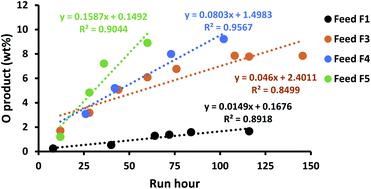当前位置:
X-MOL 学术
›
Sustain. Energy Fuels
›
论文详情
Our official English website, www.x-mol.net, welcomes your
feedback! (Note: you will need to create a separate account there.)
Pilot-scale hydrotreating of catalytic fast pyrolysis biocrudes: process performance and product analysis
Sustainable Energy & Fuels ( IF 5.0 ) Pub Date : 2021-08-12 , DOI: 10.1039/d1se00540e Sylvain Verdier 1 , Ofei D. Mante 2 , Asger B. Hansen 1 , Kristoffer G. Poulsen 3 , Jan H. Christensen 3 , Nadia Ammtizboll 1 , Jostein Gabrielsen 1 , David C. Dayton 2
Sustainable Energy & Fuels ( IF 5.0 ) Pub Date : 2021-08-12 , DOI: 10.1039/d1se00540e Sylvain Verdier 1 , Ofei D. Mante 2 , Asger B. Hansen 1 , Kristoffer G. Poulsen 3 , Jan H. Christensen 3 , Nadia Ammtizboll 1 , Jostein Gabrielsen 1 , David C. Dayton 2
Affiliation

|
Catalytic fast pyrolysis (CFP) is a technology option for producing advanced biofuels from hydrocarbon-rich biocrude intermediates. The relatively high oxygen content of biocrudes compared to petroleum intermediates increases hydrogen consumption and the lower thermal stability accelerates catalyst deactivation and reactor fouling hindering the adaptation of hydrotreating technology for biocrude upgrading into biofuels. In this study, four chemically different biocrude feeds were upgraded in a pilot scale hydroprocessing unit at similar process conditions using a commercial hydrodeoxygenation (HDO) catalyst. The biocrude feeds and hydrotreated products were characterized using standard ASTM procedures and advanced analytical techniques (GCxGC-FID and GCxGC-MS). HDO catalyst activity was monitored by changes in physical properties and chemical composition of the upgraded products as a function of time on stream. Aliphatic acids, ketones, aldehydes, and furan derivatives were completely converted during the hydrotreating tests while the concentration of aromatics, aliphatic hydrocarbons and phenolics increased during the hydrotreating tests. The oxygen content, nitrogen content, specific gravity, viscosity and the heavy end of the boiling point range (determined by simulated distillation) of the upgraded products increased with increasing time on stream during hydrotreating. The deactivation rate was the lowest for the biocrude feed that contained the most aliphatic and aromatic hydrocarbons and was the highest for the biocrude feed that had the most anhydrosugars. Overall, the HDO deactivation rate correlates with the total amount of oxygen in the feed (17 wt% to 29 wt%, on a wet basis).
中文翻译:

催化快速热解生物原油的中试加氢处理:工艺性能和产品分析
催化快速热解 (CFP) 是一种从富含碳氢化合物的生物原油中间体生产先进生物燃料的技术选择。与石油中间体相比,生物原油的含氧量相对较高会增加氢气消耗,而较低的热稳定性会加速催化剂失活和反应器结垢,从而阻碍了加氢处理技术将生物原油升级为生物燃料的适应性。在这项研究中,使用商业加氢脱氧 (HDO) 催化剂在类似的工艺条件下,在中试规模的加氢处理装置中升级了四种化学性质不同的生物原油原料。使用标准 ASTM 程序和先进的分析技术(GCxGC-FID 和 GCxGC-MS)表征生物原油进料和加氢处理产品。HDO 催化剂活性通过升级产品的物理性质和化学组成随运行时间的变化进行监测。脂肪酸、酮、醛和呋喃衍生物在加氢处理试验期间完全转化,而芳烃、脂肪烃和酚类化合物的浓度在加氢处理试验期间增加。升级产品的氧含量、氮含量、比重、粘度和沸点范围的重端(通过模拟蒸馏确定)随着加氢处理过程中运行时间的增加而增加。含有最多脂肪烃和芳烃的生物原油原料的失活率最低,而含有最多脱水糖的生物原油原料的失活率最高。全面的,
更新日期:2021-08-13
中文翻译:

催化快速热解生物原油的中试加氢处理:工艺性能和产品分析
催化快速热解 (CFP) 是一种从富含碳氢化合物的生物原油中间体生产先进生物燃料的技术选择。与石油中间体相比,生物原油的含氧量相对较高会增加氢气消耗,而较低的热稳定性会加速催化剂失活和反应器结垢,从而阻碍了加氢处理技术将生物原油升级为生物燃料的适应性。在这项研究中,使用商业加氢脱氧 (HDO) 催化剂在类似的工艺条件下,在中试规模的加氢处理装置中升级了四种化学性质不同的生物原油原料。使用标准 ASTM 程序和先进的分析技术(GCxGC-FID 和 GCxGC-MS)表征生物原油进料和加氢处理产品。HDO 催化剂活性通过升级产品的物理性质和化学组成随运行时间的变化进行监测。脂肪酸、酮、醛和呋喃衍生物在加氢处理试验期间完全转化,而芳烃、脂肪烃和酚类化合物的浓度在加氢处理试验期间增加。升级产品的氧含量、氮含量、比重、粘度和沸点范围的重端(通过模拟蒸馏确定)随着加氢处理过程中运行时间的增加而增加。含有最多脂肪烃和芳烃的生物原油原料的失活率最低,而含有最多脱水糖的生物原油原料的失活率最高。全面的,











































 京公网安备 11010802027423号
京公网安备 11010802027423号